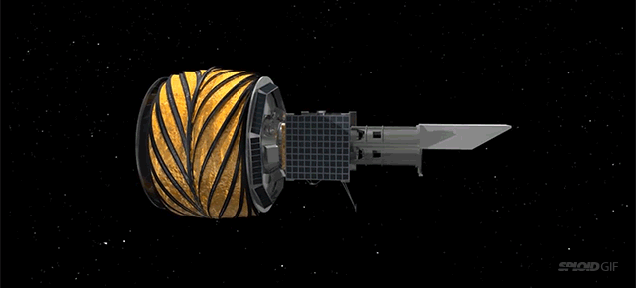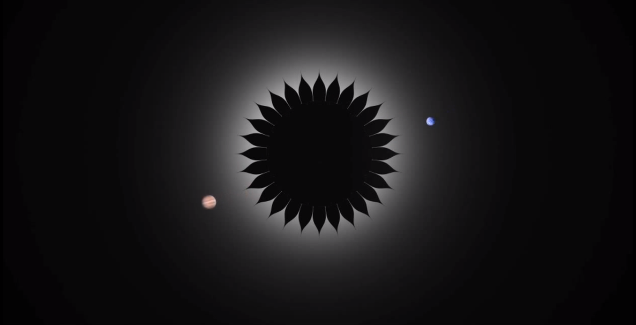Starshade - search habitable planets
A sunflower-shaped spacecraft can help scientists find habitable planets. A sunflower-shaped apparatus called Starshade unfolds its petals, blocking the star's light, and thus helps space telescopes to take pictures of exoplanets surrounding a darkened star. This would greatly facilitate the task of finding the "twins" of the Earth.


We continue a series of posts about space, this time about the NASA pilot project - Starshade. It is still in early development. “This is a very high-tech shield in space,” said Sarah Seeger, an MIT scientist, astrophysicist and NASA's Starshade Science and Technology team chairman. “It blocks the light emanating from the star. Thus, only the light of the planet enters the telescope. Now everything works quite differently, telescopes see everything. What we offer is the only way to find habitable planets with a relatively small and simple telescope, ”says Seager.
')
According to current estimates, the mission will cost about $ 1 billion, and will be able to explore the space of about 55 bright stars for 3 years. Seeger believes it is possible to find Earth-like planets orbiting around 22 out of 55 stars planned for exploration. One of the main advantages of Starshade is that astronomers will not need to add a large and incredibly expensive space telescope to it as a pair. According to Seeger, blocking the light of the stars, Starshade eliminates the need for a huge telescope. “Using Starshade, you no longer need a very technological and huge telescope that is thermally and mechanically stable,” says Seager. “In conjunction with Starshade, you can use any old space telescope. We can buy such a telescope. In fact, this is what we are thinking now. It sounds a little ridiculous from a NASA employee, but believe me, any telescope will work for this system. ”

Creating Starshade is a serious challenge for engineers. While the telescope and Starshade can be launched together, Starshade will have to fly away from the telescope when the vehicles reach outer space. “In the basic concept of the project, Starshade is a device 34 meters in diameter that flies at a distance of about 37,000 km from the telescope,” says Seager. “This is difficult and even sounds crazy. Regardless of how the mission is accomplished, it is still very complex. But it’s just as difficult to create a large telescope, which itself adjusts starlight with the help of technology. ”
Starshade itself must be designed with extreme precision so that it can effectively block the light. Researchers at Princeton University in New Jersey and NASA's California Jet Propulsion Laboratories are working on testing Starshade models. “Our current task is to figure out how to deploy Starshade in space so that all the petals end up in the right place with millimeter accuracy,” said Princeton University professor Jeremy Kasdin, principal researcher of Starshade.
With the help of Starshade, scientists plan to find the atmosphere around space objects. According to Seeger, the Kepler telescope and the TESS launched in 2017 use the transit method (the space object is fixed at the moment of passage against the background of a star) and it does not allow detecting a thin strip of atmosphere around objects.
Additional useful materials:
1. Detailed presentation of the Starshade project (technical characteristics of the device, telescope and optics, goals, principle of operation, diagrams; eng. Language)
2. The e- book of Starshade project manager at NASA, Professor MIT, Sarah Seager “There Is A Life Out There” (eng. Language)
3. Recent posts about the discovery of new planets: 1) NASA: 715 new planets found, 4 of them may be suitable for life ; 2) Oort cloud - we are waiting for the mass of discoveries .
4. The NASA Exoplanet Exploration Program , responsible for exoplanet detection research.


We continue a series of posts about space, this time about the NASA pilot project - Starshade. It is still in early development. “This is a very high-tech shield in space,” said Sarah Seeger, an MIT scientist, astrophysicist and NASA's Starshade Science and Technology team chairman. “It blocks the light emanating from the star. Thus, only the light of the planet enters the telescope. Now everything works quite differently, telescopes see everything. What we offer is the only way to find habitable planets with a relatively small and simple telescope, ”says Seager.
')
According to current estimates, the mission will cost about $ 1 billion, and will be able to explore the space of about 55 bright stars for 3 years. Seeger believes it is possible to find Earth-like planets orbiting around 22 out of 55 stars planned for exploration. One of the main advantages of Starshade is that astronomers will not need to add a large and incredibly expensive space telescope to it as a pair. According to Seeger, blocking the light of the stars, Starshade eliminates the need for a huge telescope. “Using Starshade, you no longer need a very technological and huge telescope that is thermally and mechanically stable,” says Seager. “In conjunction with Starshade, you can use any old space telescope. We can buy such a telescope. In fact, this is what we are thinking now. It sounds a little ridiculous from a NASA employee, but believe me, any telescope will work for this system. ”

Creating Starshade is a serious challenge for engineers. While the telescope and Starshade can be launched together, Starshade will have to fly away from the telescope when the vehicles reach outer space. “In the basic concept of the project, Starshade is a device 34 meters in diameter that flies at a distance of about 37,000 km from the telescope,” says Seager. “This is difficult and even sounds crazy. Regardless of how the mission is accomplished, it is still very complex. But it’s just as difficult to create a large telescope, which itself adjusts starlight with the help of technology. ”
Starshade itself must be designed with extreme precision so that it can effectively block the light. Researchers at Princeton University in New Jersey and NASA's California Jet Propulsion Laboratories are working on testing Starshade models. “Our current task is to figure out how to deploy Starshade in space so that all the petals end up in the right place with millimeter accuracy,” said Princeton University professor Jeremy Kasdin, principal researcher of Starshade.
With the help of Starshade, scientists plan to find the atmosphere around space objects. According to Seeger, the Kepler telescope and the TESS launched in 2017 use the transit method (the space object is fixed at the moment of passage against the background of a star) and it does not allow detecting a thin strip of atmosphere around objects.
Additional useful materials:
1. Detailed presentation of the Starshade project (technical characteristics of the device, telescope and optics, goals, principle of operation, diagrams; eng. Language)
2. The e- book of Starshade project manager at NASA, Professor MIT, Sarah Seager “There Is A Life Out There” (eng. Language)
3. Recent posts about the discovery of new planets: 1) NASA: 715 new planets found, 4 of them may be suitable for life ; 2) Oort cloud - we are waiting for the mass of discoveries .
4. The NASA Exoplanet Exploration Program , responsible for exoplanet detection research.
Source: https://habr.com/ru/post/217727/
All Articles